Learning styles and motives of postgraduate
distance learners undertaking a United
Kingdom professional doctorate
Amy L. Sheppard
Aston University, UK
Introduction
Learning styles have been formally defined as “characteristic cognitive, affective and psychological behaviours that serve as relatively stable indicators of how learners perceive, interact with, and respond to the learning environment” (Keefe, 1979).The study of learning styles is based upon the principle that individuals approach learning in different ways (Brown, 2004); for example, some feel confident with theories and abstract concepts, whilst others prefer facts and real-life situations; some learners prefer to think carefully about material and others favour an active approach, discussing and applying information; some are confident with visual information such as diagrams and pictures, but others prefer text and verbal explanations. Importantly, there are no “optimal” or “inferior” learning styles; the various styles are merely different from each other (Felder & Brent, 2005).
Are learning styles relevant to educators?
Over the last three decades, at least 71 learning style instruments have been developed (Coffield, Moseley, Hall, & Ecclestone, 2004; Hall & Moseley, 2005) and applied to learners at various academic levels, across a broad range of disciplines. It has been suggested that in order to maximise their efficacy, all teaching staff should have a detailed understanding of the range of learning styles in their academic environment and provide a learning experience based upon this knowledge. (Coffield et al., 2004) Although attempting to match learning and teaching styles might seem a valid approach to promote effective learning (Hayes & Allinson, 1996), there are some potential disadvantages. Matching teaching to suit a particular learning style will disadvantage those with alternative learning styles (Felder, 1993), and any group of learners is likely to include a range of styles. Furthermore, it is possible that a mismatch may actually improve learning outcomes due to the additional challenge of the learning environment, helping to avoid boredom (Grasha, 1972). Relatively recently, Felder and Brent (Felder & Brent, 2005) acknowledged that a balanced teaching style can be highly effective, but proposed that knowledge of learning styles amongst a class remains important because if strong preferences exist amongst the majority of a student cohort, the instructor should endeavour to supplement learning materials and activities to address this (these) style(s).
Learning style instruments
Of the available instruments for assessment of learning style, many were developed for use with management staff (e.g. Honey and Mumford’s Learning Styles Questionnaire (Honey & Mumford, 1986)) or children (e.g. Perrin’s Primary Version Learning Style Inventory (Perrin, 1981)). The Index of Learning Styles (ILS; Felder & Soloman, 2004) was designed for use in higher education settings, and has been employed extensively to assess the learning styles of business (De Vita, 2001), science (Buxeda & Moore, 1999) and engineering (Buxeda, Jiménez, & Morrell, 2001; Smith, Bridge, & Clarke, 2002) undergraduates. The ILS assesses learning style preferences along four dimensions, as defined by Felder and Silverman (Felder & Silverman, 1988). The dimensions are sensory-intuitive (based on the information that the student perceives preferentially: sights/ sounds/ physical sensations, or memories and thoughts); active-reflective (how the student prefers to process information: through participation in activities/ discussion, or by contemplation); visual-verbal (related to the type of material that the student prefers: images/ diagrams/ demonstrations, or written and spoken explanations) and sequential-global (how the student is able to progress towards understanding a topic: in linear steps, with steps following a logical progression, or in big jumps). The ILS has been assessed in terms of its validity (Felder & Spurlin, 2005; Litzinger, Lee, Wise, & Felder, 2007; Zywno, 2003) and construct validity (Litzinger, Lee, Wise, & Felder, 2005), with high test-retest reliability also demonstrated (Livesay, Dee, Nauman, & Hites, 2002; Zywno, 2003).
The distance learning modality
Distance learning represents an important area for pedagogical research, given that an increasing number of courses are now available online (Wighting, Liu, & Rovai, 2008). Thompson (Thompson, 1998) suggested that as the dynamic and heterogeneous nature of distance learners prevents determination of a “typical student” profile, student characteristics should be continually assessed, whilst Diaz and Cartnal (Diaz & Cartnal, 1999) also advocated the assessment of learning styles amongst distance learners, particularly when educators are planning novel programmes. Given that distance learning courses typically involve more social isolation than on-campus programmes, students have a greater requirement for independent learning skills (Diaz & Cartnal, 1999), and those that have less need for concrete experiences in learning (e.g. reflective learners) may be best suited to the distance modality.
Motives for postgraduate study
Previously published work has explored motives for different forms of postgraduate study including PhD research (Brailsford, 2010) and taught courses (Liu, 2010; Rovai, Ponton, Wighting, & Baker, 2007). Brailsford (Brailsford, 2010) conducted semi-structured interviews on 11 history PhD students in Australia, determining that the key motives for their studies could be classified into three categories: influences from friends, family and colleagues; personal motives, i.e. for a sense of achievement; and career considerations, such as entry into academia. Liu (Liu, 2010) undertook a larger study, using a questionnaire with Likert scale scoring to determine the motives for postgraduate study in the field of marketing in the United Kingdom (UK). Amongst the 94 respondents, the primary motivators were identified as intrinsic, i.e. to fulfil personal goals, or career-related. Extrinsic influence i.e. expectations from parents/ family or to follow friends, were of low significance in this investigation, where over 50% of respondents were of South-East Asian, or other Asian, nationality. Wighting and Baker (2007) found no motivational differences based on ethnicity in 353 United States under- and postgraduates, using a questionnaire approach (Academic Motivation Scale). Conversely, an earlier study (Mazzarol & Soutar, 2002) of prospective under- and postgraduate students in China, India, Indonesia and Taiwan had concluded that international students are likely to be ‘pushed’ by their parents into seeking education.
Purpose of the present study
The overall research question on which this study was based was “What are the learning styles and motives for study for students undertaking a UK professional doctorate?” The unique nature of the particular course (fully online doctorate) and diverse student body means that some interesting factors relating to motivation and learning styles could be revealed. Furthermore, both student motivation and learning styles could be relevant to educationalists involved in programme design (McLoughlin, 1999).
Professional doctorates are a relatively recent academic qualification and have been available in the UK since the 1990s, enabling students to develop their professional practice, and make a contribution to theory and practice in their field. This type of postgraduate programme may make effective use of technology for off-campus delivery (Danby & McWilliam, 2005). Professional doctorates are available in a broad range of disciplines, and typically involve a taught component with a substantial personal research project. Since 2008, Aston University (Birmingham, UK) has offered a professional doctorate in optometry, the Doctor of Optometry (DOptom). As approximately one-third of DOptom students are of non-EU nationality, particularly Malaysian and Singaporean, and the programme is notable in that students can work towards a doctoral level qualification via distance learning, investigation of the motivating factors for student study could provide some really interesting and useful data. Knowledge of students’ motives relating to postgraduate study could help to deliver the most rewarding educational experiences, as well as tailor promotions and external communications relating to this programme, and other similar programmes, in the most appropriate ways. If strong learning preferences exist amongst the distance learners, these data would be useful to allow academic staff to reflect on their teaching approaches, ensuring they are balanced, and not disadvantaging a particular learning style which may be associated with many of the cohort.
Methodology
The study was reviewed and approved by the ethics committee of the Aston University Centre for Learning, Innovation and Professional Practice (CLIPP). All active students on the DOptom programme at Aston University were invited via two email announcements (two weeks apart) to participate in the questionnaire-based study. Students on a formal leave of absence from the programme (n = 5) were not invited; 66 students were therefore eligible to participate. Email announcements stated the purpose of the study, the voluntary basis of participation, and contained a link to the online questionnaire, hosted by eSurveysPro.com. Participants were informed that no data allowing individuals to be identified would be used in any outputs from the study. The online questionnaire consisted of three sections: general information (four questions on gender, year of birth, nationality and country of residence), ILS (Felder & Soloman, 2004; 44 forced-choice two-option questions) and motives for study (14 questions, as employed by Liu (Liu, 2010)). Data were collected during October and November 2012.
Index of Learning Styles
The ILS assesses learning styles along four dimensions, with 11 forced-choice (a or b) items per dimension. Each ‘a’ or ‘b’ option corresponds to one aspect of the particular dimension (e.g. active or reflective). Individual participants’ responses from the e-survey were entered by the investigator into the online ILS site (http://www.engr.ncsu.edu/learningstyles/ilsweb.html). For each participant, scores along the dimensions were categorised as indicated by the ILS site, for example, along the active-reflective dimension, the five possible preferences were: strong preference for active learning; moderate preference for active learning; balanced between the two dimensions; moderate preference for reflective learning and strong preference for reflective learning. For the purposes of statistical analysis, these five preferences were designated a value from 1-5, so a strong preference for active learning was represented by one, moderate preference for active was two, balance between the two dimensions was three, moderate preference for reflective was four, and a strong preference for reflective was five.
Motives for study
The 14 items relating to motives for study (Table 1) were those validated by Liu (Liu, 2010), which assess the importance of intrinsic factors (five items), extrinsic factors (four items), and career-related factors (five items) as motivators for undertaking postgraduate study. Respondents are required to rate their agreement with each statement on a five-point Likert scale. To facilitate statistical analysis, numerical values were added to the Likert scale such that one represented strong disagreement, and five corresponded to strong agreement. For each participant, mean scores across the intrinsic, extrinsic and career-related items were determined.
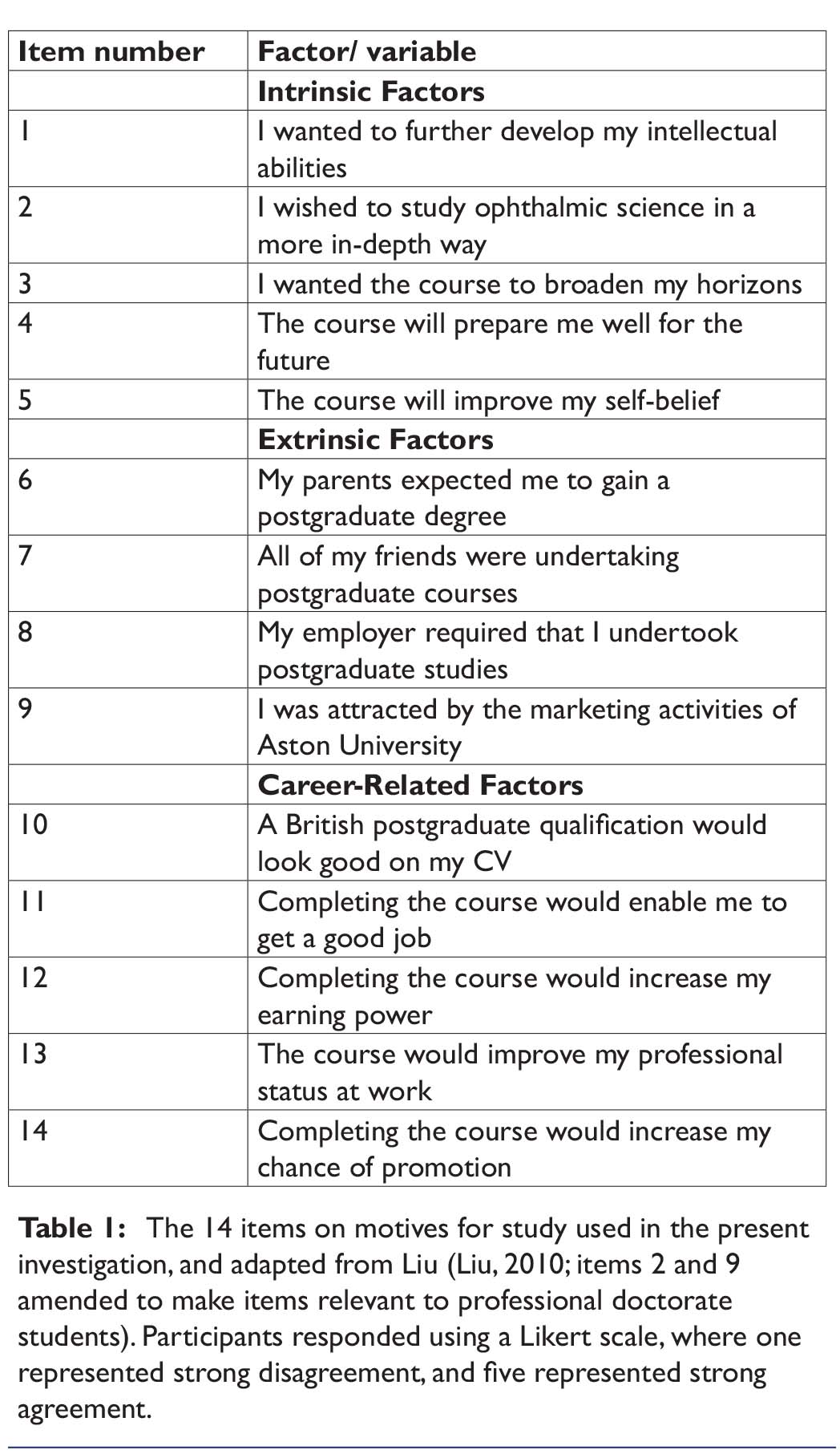
Statistical analyses
Data were entered and stored in an Excel 2010 spreadsheet (Microsoft Corp., Redmond, WA), with statistical analyses performed using SPSS v18.0 (IBM, Armont, NY). As the data regarding learning style preferences and motives for study were not normally distributed, non-parametric tests were used. Mann-Whitney U-tests were employed to determine whether the scores representing each of the four learning dimensions were different from a balanced learning style along that dimension. Regarding motives for study, Kruskal-Wallis tests were used to identify significant differences between the reported importance of intrinsic, extrinsic, and career-related factors. Mann-Whitney U-tests were then used to examine whether the importance of intrinsic, extrinsic and career-related varied significantly between home and non-UK students. All findings were assessed for statistical significance at the α = 0.05 level.
Results
Subjects
Of the 66 students eligible to participate, 24 completed the online survey, representing a 36.4 % response rate. Ten respondents (41.7 %) were female, and the mean age of participants was 35.8 ± 6.9 years. 13 participants were British (living in the UK), and 11 were of non-British nationality/ residency (four Singaporean, two Malaysian, two Irish, one Greek, one Egyptian and one American).
Learning styles
The data indicated balanced learning preferences amongst the cohort along three of the four dimensions. Mann-Whitney U-tests indicated no significant differences between the cohort responses and a balanced learning style along the active-reflective (Fig. 1a; P = 0.522), sensing-intuitive (Fig. 1b; P = 0.135) and sequential-global (Fig. 1d; P = 0.399) dimensions. Along the visual-verbal dimension, a statistically significant visual preference was identified (Fig. 1c; P <0.001). Ten respondents (41.7 %) had a strong preference for visual learning, and 19 respondents (79.2 %) had either a strong or moderate preference for visual.
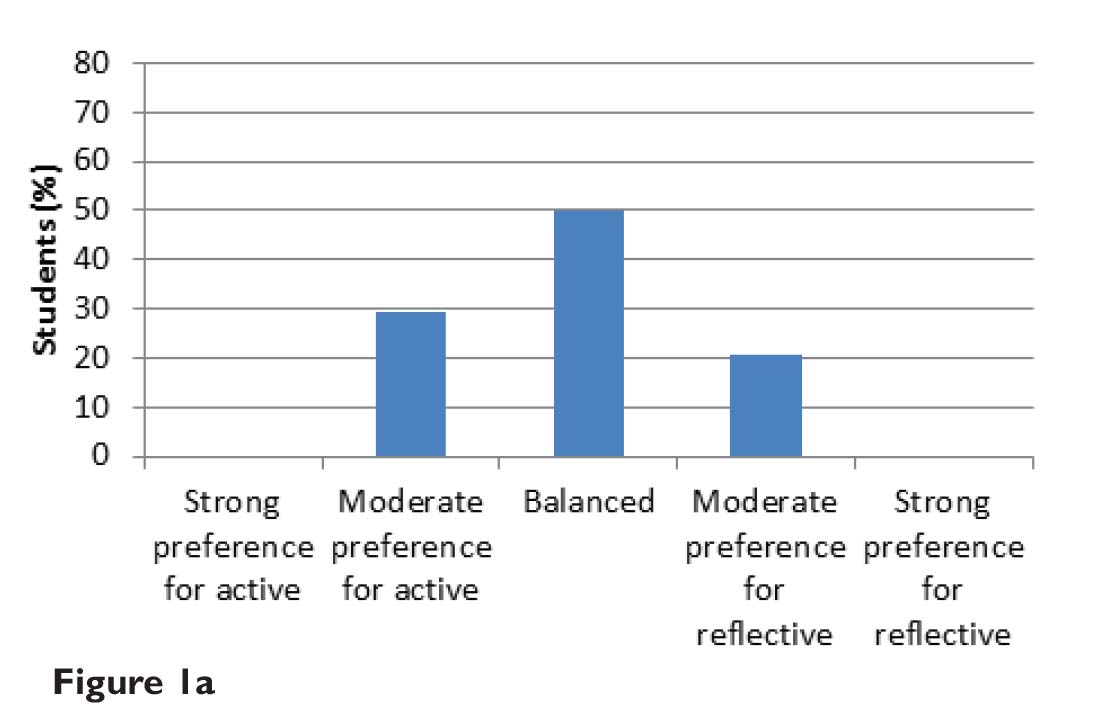
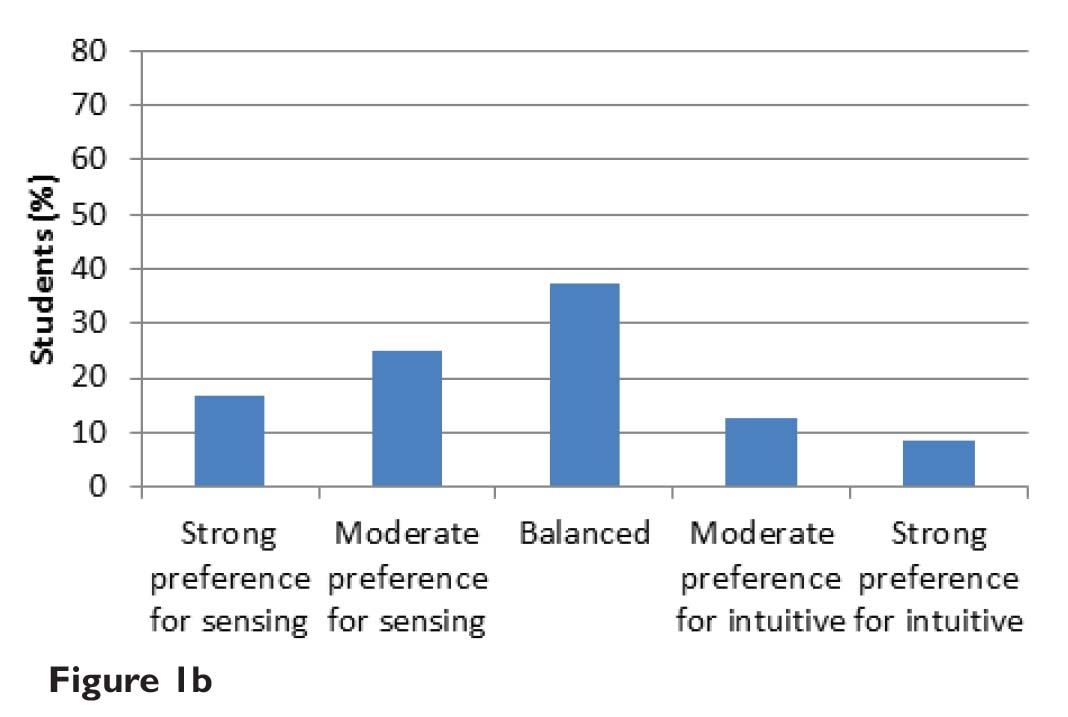
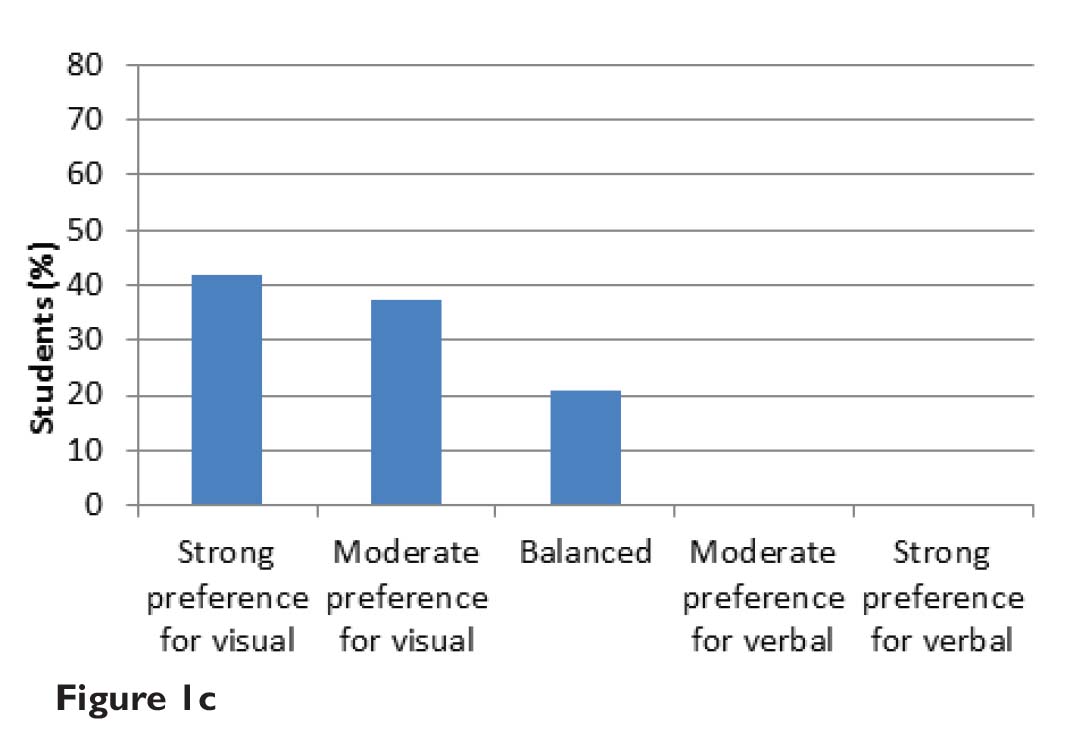
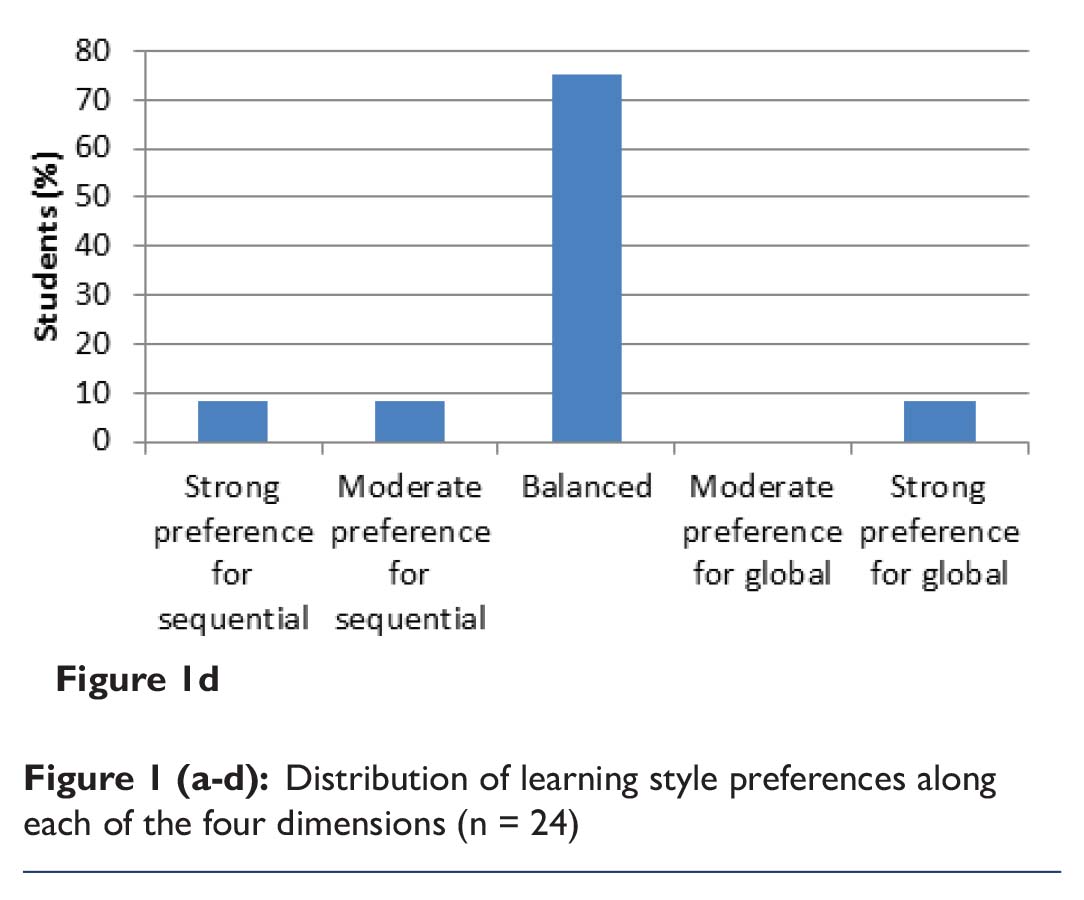
Motives for study
Across all participants, the median scores representing the importance of intrinsic, extrinsic and career-related factors were 4.40, 2.00 and 3.40, respectively. Kruskal-Wallis testing indicated that these differences were statistically significant (P <0.001), and Tukey post hoc multiple comparison analysis confirmed that responses relating to all of the three types of factor were significantly different from each other (P <0.05 for all comparisons). Intrinsic motivators were therefore most important to participants, followed by career-related factors, with extrinsic factors having a low importance to students in terms of motivation for study. Mann-Whitney U-testing showed no significant differences between UK and non-UK students in terms of the importance of the three types of motivating factor (P values of 0.253, 0.355 and 0.635 for intrinsic, extrinsic and career-related factors, respectively).
Discussion
This study has investigated the learning preferences and motives for study relating to distance-learning professional doctorate students; the author could identify no previously published studies in this distinct area. As online courses grow in popularity, an understanding of learning styles and their implications, and the motives for postgraduate study, is valuable to UK course providers. The paper next discusses the outcomes and implications of the study, with a consideration of the limitations and reliability/ validity of findings. Potential areas for future investigation in this field are also discussed, along with the practical implications of the study.
Learning styles
Regarding learning styles, respondents displayed balanced styles across three dimensions, although a significant preference for visual learning was identified along the visual-verbal dimension. Whilst there is considerable ongoing debate relating to how educators should use data on learning styles, and whether any attempt should be made to “match” learning and teaching styles (Diaz & Cartnal, 1999; Felder & Spurlin, 2005; Prajapati, Dunne, Bartlett, & Cubbidge, 2011), it has been advocated that those with a strong preference for one end of a dimension may have real difficulty in studying in an environment that does not support that preference (Felder, 1993; Felder & Brent, 2005). Ten of the 24 respondents (41.7 %) had a strong preference for visual learning; visual learners respond best to what they see, e.g. pictures, figures, diagrams, flow charts and demonstrations, and are poorer at remembering words and verbal explanations (Felder & Silverman, 1988). Visual learners may therefore struggle with modules/ tasks on the programme that require a significant amount of directed reading or are delivered mainly in text. Further research could be undertaken involving a retrospective analysis of individual students’ results in specific modules to confirm this hypothesis, although other factors are likely to affect overall module result, e.g. students who are new to the programme and have not studied for a number of years may find it difficult to re-adapt to learning in higher education, particularly if they have no experience with virtual learning environments. It may be appropriate for the module convenors of the less-balanced modules (along the visual-verbal dimension) to consider ways in which they might support strongly-visual learners; approaches could involve the inclusion of video demonstrations and pictures/ diagrams wherever possible to illustrate pertinent points.
Previous research has indicated that independent and reflective learners may cope best with a distance learning modality (Diaz & Cartnal, 1999). The results of the present investigation indicated that those enrolled on the optometry professional doctorate programme are typically balanced along the active-reflective dimension. No respondents had a strong preference for either end of the scale, indicating that the current cohort is likely to be able to adapt to either active or reflective modes of student participation, so should not be disadvantaged by the reflective and inherently more independent nature of the programme.
Learning styles do not necessarily remain fixed in individuals; several previous studies have documented a change in learning styles with time (Marriott, 2002; Nulty & Barrett, 1996; Zeegers, 2001). A limitation of the present investigation is its cross-sectional nature, representing a single point in time. It is feasible that during the course of a student’s study on the professional doctorate programme that their learning style may alter. Future work in this field could perhaps examine the learning styles of these students on a longitudinal basis, or compare the learning preferences of new students to those who have completed the doctorate; this is not possible at present due to the relatively new status of the programme.
Of note is the dual assumption in the present study that learning styles genuinely exist and are useful; this is a slightly contentious issue with some authors questioning the validity of learning style instruments and claiming that knowledge of supposed learning styles does not enhance learning (Dembo & Howard, 2007; Riener & Willingham, 2010). Willingham argues that other factors such as personal interests, abilities and background knowledge are the key student differences relevant to learning and that learning styles are a “myth” (Riener & Willingham, 2010; Willingham, 2008). The present study does not provide an insight into this debate, which seems likely to continue with proponents for both theories.
Motives for study
The results relating to motives for study were similar to those of some previous studies that have identified that online learners are more driven by intrinsic goals than equivalent on-campus students (Diaz & Cartnal, 1999; Wighting et al., 2008). Respondents in the present investigation were strongly driven by intrinsic factors, e.g. a desire to improve one’s own self-belief and intellectual abilities. Brailsford (Brailsford, 2010) recently identified that the most important motives for undertaking doctoral study amongst a cohort of history students were a strong interest in the research project itself, and a desire to reach the pinnacle of academic achievement. Whilst history and optometry cannot be directly compared due to differences in the nature of the subjects, the optometry professional doctorate does allow students flexibility to decide on their own research project, ensuring it is a field in which they are interested, with thesis submission leading to the award of a doctoral degree.
Extrinsic factors, relating to the expectations of family/ friends/ employers, and the marketing activities of the university did not provide significant motivation for respondents to undertake the professional doctorate programme. Furthermore, there was no evidence from the current study to support the hypothesis that East Asian students are likely to be more affected by extrinsic “push” factors (Mazzarol & Soutar, 2002); no significant differences were identified between UK and non-UK students in terms of the importance of intrinsic, extrinsic and career-related factors. It is possible that had the cohort size been larger (i.e. a higher response rate), some differences may have been revealed between EU and East Asian students. However, the limited amount of data precluded such a comparison, with just six East Asian respondents. It was therefore necessary to classify students as UK or non-UK in order to get the most evenly matched group sizes (13 and 11, respectively). The fairly low response rate (36.4 %) represents a limitation of the study as it is feasible that findings may have been different if there were significantly more respondents. However, the response rate was in line with many web-based surveys (Fan & Zheng, 2010), although one might have expected more respondents given that the survey was not too time-consuming and original email invitations were followed up a fortnight later. Future questionnaire-based research relating to online distance learners might benefit from the use of multiple modes of survey delivery and pre-notifications of the study (Sheehan, 2001).
Implications for practitioners
Given the many available online survey tools, it is now straightforward for practitioners to conduct a survey to examine the learning styles of their students, even those who may be based off-campus/ overseas. Use of online tools can minimise both the time required and the cost of conducting a questionnaire, with some sites offering a free service. As in the present investigation, study of learning styles may reveal some unexpected strong learning preferences amongst a cohort which require consideration, and possible modification of, professional practice. As discussed previously, the matching of learning and teaching styles is likely to be an inappropriate strategy, but the discovery of strong preferences may require practitioners to consider whether their material and mode of delivery are appropriate. Felder (Felder & Brent, 2005) states that the most effective teaching style is balanced across the dimensions of a chosen learning style instrument, and to teach in a way that heavily favours a particular learning style may confer an unfair advantage to particular students. Major changes to one’s teaching style are unlikely to be necessary; regular use of a small number of additional teaching methods is likely to be sufficient to cover the needs of all learners in a class. Possible methods of adapting teaching styles in science education have been described (Felder, 1993), but may be as simple as providing real-life examples when teaching algebraic material (sensing/ intuitive dimension).
Given that intrinsic factors represented the most important motives for study in this investigation, course leaders may wish to consider this when designing and promoting programmes. Postgraduates on similar programmes are likely to be driven by a desire to improve their intellectual capabilities and broaden their scope of knowledge in a particular field, rather than being influenced by other individuals. The participants surveyed in the present investigation were all mature students, with professional qualifications; the data support previously published work that indicated mature students are more likely to be motivated by intrinsic goals, and adopt a deeper approach to learning than learners who are recent school-leavers (Fazey & Fazey, 2001; Richardson, 1994). For those practitioners leading courses with a mixture of mature learners and recent school-leavers, a challenge exists to promote deep learning to both groups of students.
Conclusion
In summary, the present study has indicated that learning styles may be easily studied amongst cohorts of distance learning students, and has the potential to reveal preferences that educators should consider in their teaching activities. In line with some previously published work, intrinsic factors were the most important motives for study in this cohort of mature learners, with extrinsic factors being of low importance. No evidence was found to support the assertion that East Asian students are more likely to be affected by extrinsic push factors.